This guide offers information and tips to disaster responders and first responders to help them manage stress during crisis response. It describes how stress affects the body and suggests ways for individuals and organizations to promote and engage in stress management.
Dashboard: Filter Bricks
Main page content

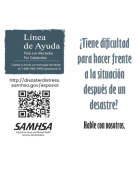
This wallet-size card includes the national Disaster Distress Helpline and lists warning signs of distress. It encourages those experiencing signs of psychological stress to call or text the helpline for support.

This brochure features the national Disaster Distress Helpline, which supports people who are coping with the after effects of a disaster. Learn about a disasters’ potential to cause psychological stress, warning signs of distress, and tips for coping.


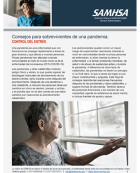
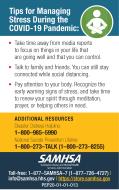
The wallet card provides stress reduction tips and techniques as well as lists sources for additional assistance.
Kev Sib Tham Nrog Cov Me Nyuam Yaus: Cov Tswv Yim Qhia Rau Cov Neeg Zov, Cov Niam Txiv, Thiab Cov Xib Qhia Ntawv Rau...
This tip sheet will help parents, caregivers, and teachers learn some common reactions, respond in a helpful way, and know when to seek support. HMONG Language Version.
This tip sheet will help parents, caregivers, and teachers learn some common reactions, respond in a helpful way, and know when to seek support. SOMALI Language Version.
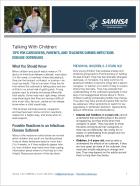
This fact sheet provides parents, caregivers, and teachers with strategies for helping children manage their stress during an infectious disease outbreak. It describes potential reactions among youth and the support adults can provide to help them.

This fact sheet provides Health Care Practitioners and Disaster Responders with guidelines for communicating with survivors experiencing grief. It give background information about the grieving process and what happens when the grief process is interrupted and complicated or traumatic grief occurs is included as well as helpful resources for additional assistance.

This tip sheet contains information about grief, the grieving process, and what happens when the process is interrupted and complicated or traumatic grief occurs. It also offers tips and resources for coping with both types of grief.

This brochure explains the signs and symptoms of retraumatization. Gives guidance on how to manage the symptoms. It provides resources for building resilience and an adequate support system for dealing with triggering events.
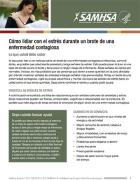
Esta hoja de consejos ofrece sugerencias para lidiar con el estrés durante un brote de una enfermedad contagiosa, como el ébola. Explica cuáles son algunas señales comunes del estrés, cómo saber cuándo pedir ayuda y algunas formas prácticas para aliviar el estrés y cuidar su salud mental

Cómo hacer frente a una emergencia en la que es necesario refugiarse en sitio
Esta hoja de consejos contesta algunas preguntas frecuentes sobre cómo hacer frente a una emergencia que requiera que usted se refugie en el sitio donde se encuentre. Ofrece consejos para lidiar con la situación; explica las reacciones comunes a tener que refugiarse en sitio; da consejos sobre cómo cuidar su salud mental y la de su familia; y proporciona recursos útiles adicionales.
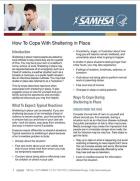
This fact sheet provides tips for coping with sheltering in place. It explains common reactions when sheltering in place, and provides recommendations for caring for oneself and the family.

This fact sheet discusses tips on how to cope with grief after an incident of community violence. It introduces common signs of grief and anger, and offers tips for helping children deal with grief.

This fact sheet provides tips for coping with stress during an infectious disease outbreak. It describes common signs of stress and how to recognize when to get help.

This fact sheet offers tips supervisors can use to help ease the transition and manage stress for disaster response workers returning to work. It helps people recognize and reduce potential difficulties in the workplace, and enhances positive consequences for all staff.

This fact sheet explains the causes and signs of compassion fatigue, which is the burnout and secondary trauma disaster response workers can experience. It offers self-care tips for coping, and discusses compassion satisfaction as a protective tool.
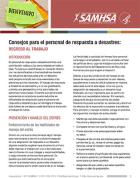
Ofrece consejos a los socorristas para ayudarlos a hacer la transición de reincorporarse de vuelta a un trabajo de rutina. Habla sobre el manejo del estrés y cómo superar las dificultades que pueden surgir, como la fatiga, el cinismo, la insatisfacción con el trabajo de rutina, y la falta de control sobre las emociones.

Ofrece consejos y estrategias que pueden usar las familias de soccoristas para ayudarlos a adaptarse a la vida diaria cuando regresan a casa. Describe las cosas que se deben tener en cuenta al ajustarse al regreso de un ser querido, cuáles son las señales de estrés y cuándo se debe buscar ayuda.
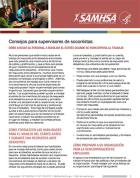
Ofrece consejos a los supervisores para ayudarles a facilitar la transición y manejar el estrés de los socorristas cuando ellos se reincorporan al trabajo. Incluye consejos sobre cómo reconocer y reducir los posibles problemas en el lugar de trabajo y crear consecuencias positivas para todo el personal.

Explica las causas y la señales de la fatiga por compasión, es decir, el agotamiento y el trauma secundario que un socorrista puede experimentar. Ofrece consejos de autocuidado para lidiar con la fatiga por compasión y se analiza la satisfacción que viene de la compasión como una herramienta de protección.

Ofrece consejos para ayudar a los socorristas a prevenir y manejar el estrés. Incluye estrategias para ayudar a los socorristas a prepararse para la tarea que les ha sido asignada, tomar precauciones para reducir el estrés mientras cumplen con la tarea asignada, y manejar el estrés en la fase de recuperación de dicha asignación.

This fact sheet offers tips to help disaster response workers transition back to routine work. It provides information on managing stress, and how to overcome other difficulties, such as fatigue and a lack of control over emotions.

Ofrece consejos de autoayuda para hacer frente a las secuelas de un evento traumático. Trata sobre el impacto a largo plazo del trauma, incluyendo las incertidumbres personales, los cambios en las relaciones familiares, las alteraciones en el trabajo y las preocupaciones financieras. Ofrece consejos para las personas que han sobrevivido un evento traumático.
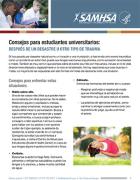
Ayuda a los estudiantes universitarios a enfrentar los efectos sobre la salud mental de las secuelas de un evento traumático. Explica las reacciones normales, hace hincapié en la importancia de hablar sobre los sentimientos y ofrece consejos para salir adelante. Incluye una lista de recursos donde se puede obtener más información.

In a disaster, it's essential that behavioral health responders have the resources they need—when and where they need them. The free SAMHSA Disaster App offers first responders immediate access for any type of traumatic event at every phase of response, including pre-deployment preparation, on-the-ground assistance and post-deployment resources.
With the SAMHSA Disaster App, first responders can:
- Access resources including tip sheets; guides for responders, teachers, parents, and caregivers; and a directory of behavioral health service providers in the impacted area.
- Download information on your phone before deployment in case of limited Internet connectivity in the field.
- Review key preparedness materials to help you provide the best support possible.
- Send information to colleagues and survivors via text message, email, or transfer to a computer for printing.
- Find interventions to help survivors of infectious disease epidemics.
Find SAMHSA’s disaster response information as a publication. Download the SAMHSA Disaster Kit.
For more information, email SAMHSA at samhsainfo@samhsa.hhs.gov

This fact sheet helps college students cope with disasters and other traumatic events. It describes normal reactions to trauma, and emphasizes the importance of talking about feelings.

Da consejos sobre cómo prevenir y manejar el estrés cuando se debe enfrentar los efectos del trauma, la violencia masiva, o el terrorismo. Tiene una lista de consejos para aliviar el estrés, describe cómo saber cuándo buscar ayuda profesional y contiene una lista de otros recursos donde obtener ayuda o información.

Sugerencias para hablar con niños y jóvenes y ayudarlos a hacer frente después de un desástre o un evento traumático: una guía para padres, cuidadores y maestros
Es un recurso útil para que usen los padres, cuidadores y educadores después de un desastre o un evento traumático. Explica cómo ayudar a los niños y jóvenes hacer frente a estos eventos y además contiene una lista de recursos útiles.

This fact sheet offers tips for preventing and managing stress when dealing with the effects of trauma, mass violence, or terrorism. It lists tips for relieving stress and seeking professional help.
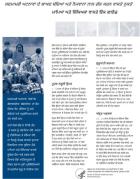
Punjabi version of KEN01-0093, prompted by a violent incident at a Sikh temple in Wisconsin in August 2012. Helps parents and teachers recognize and address problems in children and teens affected by the trauma after an act of violence. Describes signs of stress reactions that are common in young trauma survivors at different ages, and offers tips on how to help.

Punjabi version of NMH05-0209R, prompted by a violent incident at a Sikh temple in Wisconsin in August 2012.Gives stress prevention and management tips for dealing with the effects of trauma, mass violence, or terrorism. Lists tips to relieve stress, describes how to know when to seek professional help, and provides accompanying resources.

This wallet-size card includes the national Disaster Distress Helpline and lists warning signs of distress. It encourages those experiencing signs of psychological stress to call or text the helpline for support.

This brochure features the national Disaster Distress Helpline, which supports people who are coping with the after effects of a disaster. Learn about a disasters’ potential to cause psychological stress, warning signs of distress, and tips for coping.

This manual offers guidelines for medication-assisted treatment for people, particularly veterans, living with post-traumatic stress disorder and co-occurring opioid use disorders. It covers screening, concomitant treatment, pharmacotherapy, and multiple misused substances.

This field manual offers mental health and public health professionals information on disaster preparedness and recovery to assist disaster survivors. It describes survivor reactions, at-risk populations, counseling, referrals, and stress prevention and management.

